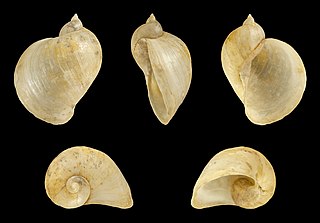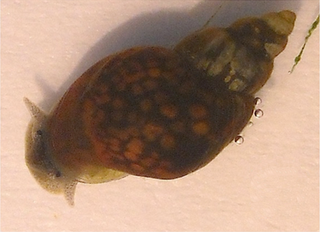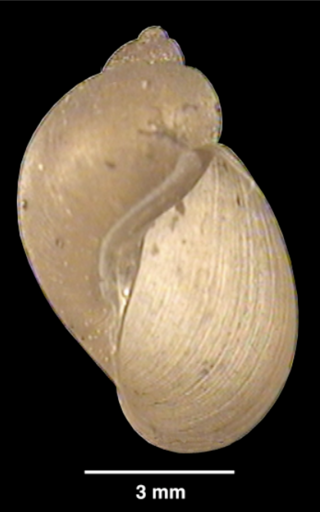
Fasciola hepatica, also known as the common liver fluke or sheep liver fluke, is a parasitic trematode of the class Trematoda, phylum Platyhelminthes. It infects the livers of various mammals, including humans, and is transmitted by sheep and cattle to humans all over the world. The disease caused by the fluke is called fasciolosis or fascioliasis, which is a type of helminthiasis and has been classified as a neglected tropical disease. Fasciolosis is currently classified as a plant/food-borne trematode infection, often acquired through eating the parasite's metacercariae encysted on plants. F. hepatica, which is distributed worldwide, has been known as an important parasite of sheep and cattle for decades and causes significant economic losses in these livestock species, up to £23 million in the UK alone. Because of its relatively large size and economic importance, it has been the subject of many scientific investigations and may be the best-known of any trematode species. F. hepatica's closest relative is Fasciola gigantica. These two flukes are sister species; they share many morphological features and can mate with each other.

Fasciola, commonly known as the liver fluke, is a genus of parasitic trematodes. There are three species within the genus Fasciola: Fasciola nyanzae,Fasciolahepatica and Fasciolagigantica. Fasciola hepatica and F. gigantica are known to form hybrids. Both F. hepatica and F. gigantica and their hybrids infect the liver tissue of a wide variety of mammals, including humans, in a condition known as fascioliasis. F. hepatica measures up to 30 mm by 15 mm, while F. gigantica measures up to 75 mm by 15 mm. Fasciola nyanzae is thought to exclusively infect the common hippopotamus, Hippopotamus amphibius.

Fasciola gigantica is a parasitic flatworm of the class Trematoda, which causes tropical fascioliasis. It is regarded as one of the most important single platyhelminth infections of ruminants in Asia and Africa. The infection is commonly called fasciolosis.

Galba truncatula is a species of air-breathing freshwater snail, an aquatic pulmonate gastropod mollusk in the family Lymnaeidae, the pond snails.

Lymnaeidae, common name the pond snails, is a taxonomic family of small to large air-breathing freshwater snails, aquatic pulmonate gastropod mollusks, that belong to the clade Hygrophila.

Lymnaea is a genus of small to large-sized air-breathing freshwater snails, aquatic pulmonate gastropod mollusks in the subfamily Lymnaeinae ( of the family Lymnaeidae, the pond snails.

Lymnaea tomentosa is a species of freshwater snail, an aquatic gastropod mollusc in the family Lymnaeidae.

Radix is a genus of air-breathing freshwater snails, aquatic pulmonate gastropods in the family Lymnaeidae, the pond snails.

Omphiscola glabra, commonly known as the pond mud snail, is a species of small to medium-size, air-breathing, freshwater snail, an aquatic pulmonate gastropod mollusk in the family Lymnaeidae. Omphiscola glabra is the type species of the genus Omphiscola.

Radix auricularia, the big-ear radix, is a species of medium-sized freshwater snail, an aquatic pulmonate gastropod mollusk in the family Lymnaeidae.

Stagnicola fuscus is a species of freshwater snail, an aquatic gastropod mollusk in the family Lymnaeidae, the pond snails.

Galba is a genus of small air-breathing freshwater snails, aquatic pulmonate gastropod mollusks in the family Lymnaeidae, the pond snails.
Austropeplea ollula is a species of air-breathing freshwater snail, an aquatic pulmonate gastropod mollusk in the family Lymnaeidae, the pond snails.
Radix luteola is a species of freshwater snail, an aquatic gastropod mollusc in the family Lymnaeidae.
Lymnaea acuminata is a species of freshwater snail in the family Lymnaeidae. It is native to South Asia, where it occurs in Bangladesh, Burma, India, Nepal, and Pakistan. There it is a widespread and common species.

Radix natalensis is a species of freshwater snail, an aquatic gastropod mollusc in the family Lymnaeidae.

Galba schirazensis is a species of air-breathing freshwater snail, an aquatic pulmonate gastropod mollusk in the family Lymnaeidae, the pond snails.

Galba cousini is a species of air-breathing freshwater snail, an aquatic pulmonate gastropod mollusk in the family Lymnaeidae, the pond snails.

Galba meridensis is a species of air-breathing freshwater snail, an aquatic pulmonate gastropod mollusc in the family Lymnaeidae, the pond snails.
Galba neotropica is a species of air-breathing freshwater snail, an aquatic pulmonate gastropod mollusk in the family Lymnaeidae, the pond snails.
















